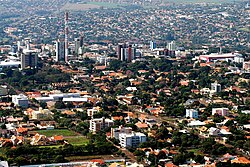Toledo, Paraná
| Toledo | |||
|---|---|---|---|
| Municipality | |||
|
Município de Toledo Municipality of Toledo |
|||
 |
|||
|
|||
| Nickname(s): Cidade de Primeiro Mundo (First World City) and Capital do Agronegócio (Capital Agribusiness) | |||
 |
|||
| Location in Brazil | |||
| Coordinates: 24°42′50″S 53°44′34″W / 24.71389°S 53.74278°WCoordinates: 24°42′50″S 53°44′34″W / 24.71389°S 53.74278°W | |||
| Country |
|
||
| Region | South | ||
| State |
|
||
| Founded | 1951 | ||
| Government | |||
| • Mayor | Lucio de Marchi (PP) | ||
| Area | |||
| • Municipality | 1,197.016 km2 (462.170 sq mi) | ||
| • Metro | 1,197.016 km2 (462.170 sq mi) | ||
| Elevation | 550 m (2,493.4 ft) | ||
| Population (2016) | |||
| • Municipality | 133.824 | ||
| • Density | 101/km2 (260/sq mi) | ||
| • Metro density | 101/km2 (260/sq mi) | ||
| Demonym(s) | Toledano | ||
| Time zone | BRT (UTC−3) | ||
| • Summer (DST) | BRST (UTC−2) | ||
| Postal Code (CEP) | 85900-001 | ||
| Area code(s) | +55 45 | ||
| Website | City of Toledo | ||
Toledo is a municipality Brazil state of Paraná. It is located in the region west near Cascavel, making this city a developing area on the Agribusiness, driven by its fertile soil and flat, which makes focusing cooperatives and other company s in the business, making it one of the largest grain producers in the state. Its population is 122,502 inhabitants, as estimated by IBGE.
The road distance to the state capital is 540 km.
Toledo is located in a region of recent settlement, and received its first residents in 1946, Gaucho settlers from the city of San Marcos, then within Caxias do Sul, then for the Território Federal do Iguaçu. In 1951, the city was liberated from Foz do Iguaçu by Law No. 790, signed by the governor of Paraná Bento Munhoz da Rocha Neto.
The first election was held on November 9, 1952, and the official installation of December 14, 1952, when he saw the inauguration of Mayor Ernesto Dalloglio (1952/1956).
In the late 1960s, the region had only five counties: Foz do Iguaçu, Cascavel, Toledo, Guaíra and Guaraniaçu.
Toledo came when Industrial lumber mill and Colonization Rio Paraná S / A - Maripá acquired from a British real estate company a tract of land called Farm Britain, then started the occupation and clearing of bringing settlers to the area of Rio Grande do Sul.
The initial activity was the logging markets to meet the Argentina and Uruguay. The plan colonization was based on small farms averaging 10 acres in São Paulo.
Thereafter the development occurred rapidly, initially around the economics of farming communities, which lent the company a strong spirit herd.
...
Wikipedia



